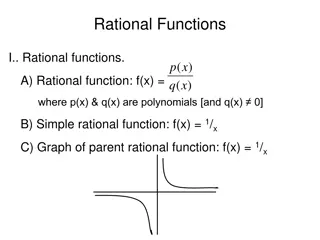Rational Use of Blood and Blood Components in Healthcare
Rational use of blood and blood components is crucial in healthcare settings to maximize resources, minimize risks, and enhance patient outcomes. This involves avoiding unnecessary transfusions, understanding the risks associated with transfusions, dispelling misconceptions, and choosing the most appropriate blood products based on patient needs. Factors such as infection risks, immunologic issues, and storage requirements should be carefully considered to ensure safe and effective blood transfusion practices.
Download Presentation

Please find below an Image/Link to download the presentation.
The content on the website is provided AS IS for your information and personal use only. It may not be sold, licensed, or shared on other websites without obtaining consent from the author. Download presentation by click this link. If you encounter any issues during the download, it is possible that the publisher has removed the file from their server.
E N D
Presentation Transcript
Rational Use of Blood and Blood Components
Best Transfusion is No Transfusion
Why Avoid Blood Transfusion? Infection Risk HIV, Hepatitis Other Complications Febrile reactions Allergic, urticarial reactions Clerical Errors ABO mismatch Immunologic Issues TA-GvHD Immunosuppression Religious Reasons
Misconceptions and Myths Whole blood Fresh Blood Empirical Transfusion Nutritional Anemia Pre Surgical Wound Healing Enhancement of well being
Why whole blood not rational Maximize blood resource Thalassemia Bleeding one unit of whole blood Aplastic anemia Hemophilia Better patient management concentrated dose of required component avoid circulatory overload minimize reactions Specific storage requirements of components Red Blood cells Platelets Fresh frozen plasma +2-60 C +220 C - 300 C Decrease cost of management except for the cost of bag, other expenses remain same
Whole Blood Vs Packed Red Cells Parameter Whole blood Packed red cells 350 450 ml 200 240 ml Volume 1 -1.5 gm/dl 1 -1.5 gm/dl Increment in Hb Same as PRBC Same as WB Red cell mass /ml No No Viable platelets No No Labile factors ++++ + Plasma citrate ++++ + Allergic reactions ++++ + FNHTR ++++ + Risk of TTI Yes No Waste of components
Fresh blood misconception. What is fresh blood ? varying definition any unit kept at 4oC for 4 hours is no longer fresh Increased disease transmission Intracellular pathogens (CMV, HTLV) survive in leukocyte in fresh blood Syphils transmission- tryponema can t survive > 96 hours in stored blood ( JAMA,95) Malaria transmission- malaria parasite cannot survive > 72 hours in stored blood (Mollison)
Fresh blood misconception. Immunological complication due to WBCs in fresh blood Transfusion Associated-Graft vs Host Disease 90% fatality TA-immunomodulation Alloimmunization- Red cell / platelet Logistics no time for component preparation less time for infection screening storage lesions in different constituents due to storage temp
Rational Use of Blood Rational Use of Blood Right product Right dose Right time Right reasons
Answer 4 Qs before transfusion Why to transfuse ? benefit > risk patients symptoms Vs lab levels prophylactic Vs therapeutic What to transfuse ? whole blood components / fractions How much to transfuse ? Single unit How to transfuse ? use of filter rate of transfusion warming NO NO
Packed Red Cells (PRBC) Packed Red Cells (PRBC) Symptomatic deficiency of oxygen carrying capacity or tissue hypoxia
Appropriate use of Packed red cells Appropriate use of Packed red cells Should be ABO and Rh compatible Clinical judgment- a vital role Co-existing conditions age, general health, cause of anemia, its severity and chronicity Not for conditions like Iron/ B12/ Folate deficiency
PRBC PRBC - - Triggers Triggers Preoperative / peri-procedural : Hb< 6g/dl Hb 6- 10 g/dl (bleeding, cardio resp. disease) Symptomatic chronic anemia : Hb < 6 g/dl Acute blood loss : > 40% blood loss > 30% continued blood loss or on respiratory support
Neonates Neonates Hemoglobin <12g/dl in first 24 hrs <12 g/dl with intensive support care <11 g/dl with chronic oxygen need < 7 g/dl in a stable infant Blood loss Stable infant > 10% loss of estimated volume Unstable infant > 5% loss of estimated blood volume
PRBC PRBC - - Dosing Dosing One unit of compatible RBC 1 g/dl or Hct by 3% Neonates Dose 10- 15 ml/kg Increase Hb - 2-3 g/dl
Issues in red cell transfusion One unit of PRBC Vol 250 ml Hct 65% Raise Hb by 1 gm/dl 200 mg iron 70% post transfusion survival Age of blood concerns regarding K level decreased post transfusion survival Specific conditions intrauterine transfusion thalassemics open heart surgery < 3 days old < 5 days < 10 days
Cardinal principles in red cell transfusion in chronic anemia Evaluate etiology of anemia - AIHA, IDA Do not transfuse just on the basis of given Hb level Try to establish whether Signs / Symptoms are due to anemia Determine if Signs / Symptoms of anemia are alleviated by transfusion Determine that temporary relief of symptoms warrants continued transfusion
Platelets Platelets Stored at room temperature (20 -22 C) Shelf life 3-5 days Judicious use Group specific
Appropriate Transfusion of Platelets Appropriate Transfusion of Platelets Symptomatic platelet problems Number related eg. Aplastic anemia Function related eg. Glanzmann s thrombasthenia Do not treat the number in isolation eg Chronic ITP with no bleeds Prophylactic in specific situations CNS, eye surgery, other major surgeries, acute leukemia, patients on chemoradiotherapy Dose: 1 RDP/10 Kg
Platelet Platelet- - Triggers Triggers Condition Platelet count Prophylaxis against bleeding < 10,000/ l Bedside invasive procedures < 50,000/ l Neurosurgical procedures, Ophthalamic surgeries < 100000/ l Massive Transfusion < 50,000/ l
Neonates Neonates Prophylactic Platelet Triggers Prophylactic Platelet Triggers Term Neonates Clinically stable - 20,000/ l Clinically sick - 30,000/ l Preterm Neonates Clinically stable - 30,000/ l Clinically sick - 50,000/ l
Contraindications Contraindications Thrombotic Thrombocytopenic purpura Heparin induced thrombocytopenia Immune Thrombocytopenic purpura
Fresh Frozen Plasma Fresh Frozen Plasma
Appropriate Transfusion of FFP Appropriate Transfusion of FFP Replacement of multiple factors: DIC, liver disease, warfarin reversal, snake bite PT/ INR should be determined Dose: 10-15 ml/kg Not for volume expansion Not for nutritional support/ hypoproteinemia
Cryoprecipitate Cryoprecipitate Out of group can be transfused but preferably ABO compatible RhD type need not be considered Thawed Cryoprecipitate transfused within 6 hours Indicated for bleeding associated with fibrinogen deficiency and factor XIII deficiency
Hemophilia A or von Willebrand disease when appropriate substitute not available Bleeding with fibrinogen levels< 100mg/dl Dose - one unit/10 kg body weight Raises fibrinogen concentration by 50 mg/dl
Choice for ABO Blood Groups Choice for ABO Blood Groups Patient type Donor PRBC Donor FFP Donor PC O Positive O O,B,A,AB O,B,A,AB A Positive A,O A,AB A,AB,O,B B Positive B,O B,AB B,AB,O,A AB Positive AB,B,A,O AB AB,B,A,O
Choice for Choice for Rh Rh Blood group Blood group Rh (D) negative patient transfused with Rh (D) positive components PRBC PRBC Only as a life saving measure and with consent from treating physician & patient s relative FFP FFP No anti-D immunoprophylaxis required PC plateletpheresis units or 30 Rh (D) positive platelet concentrates for 6 weeks) Anti D immunoprophylaxis required (300 g anti-D gives protection for 7
Cross matching: Special Circumstances Clinical urgency Minutes Within an hour Immediate Group O Rh neg Packed RBCs ABO & Rh D type ABO & Rh D type Complete crossmatch Immediate spin crossmatch ( 15-20) min) Group specific blood (5-10 min) If units are issued without X match written consent of physician to be taken, -complete X match protocols followed after issue
Take Home Messages Take Home Messages No place for Whole Blood in clinical medicine Component preparation and use is the demand of time Best Transfusion is No Transfusion Promotion of judicious use of blood / components Audit of transfusion practices CME on use of components Promote autologous use of blood Discourage single unit / fresh blood























